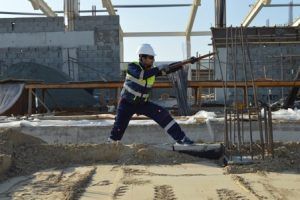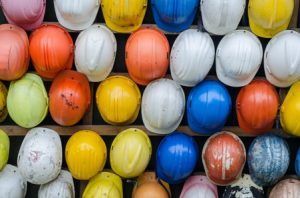Head injuries on construction sites have always been a big problem, despite a huge reduction over the last 20 years. So, in what ways can these injuries be further reduced?

Some head injuries are to be expected in an industry where objects could land on your head, and there are lots of hazards to slip, trip and fall over.
The risk of suffering a head injury should be mitigated by employers if they want to reduce the risk of their employees visiting a brain injury lawyer for compensation.
In this post, we’re going to share 10 steps to help minimise head injuries on your construction site to both protect your workers and protect the business from hefty lawsuits.
What Steps Can You Take to Minimize Head Injuries on a Construction Site?
A 2019 report by the Centre for Construction Training and Research revealed a 57 percent drop in the rate of nonfatal worker injuries in the construction industry between 2003 and 2019. Despite this reduction, the injury rate remained 29.2 percent higher than all other industries combined.
On top of this, the report found that construction workers sustain more traumatic brain injuries than employees in any other workplaces in the United States.
The question is, what can be done to reduce these brain injuries further and bring them closer to the levels in other workplaces? Here are 10 ways to achieve that goal.
1. Wear a hard hat
Wearing a hard hat, or helmet, is one of the most critical things you can do to reduce brain injuries on-site. Each country will have their own regulatory body, but in the US the Occupational Safety and Health Administration (OSHA) lay down the rules on helmets.
OSHA requires protective helmets for construction workers “working in areas where there is a possible danger of head injury from impact, or from falling or flying objects, or from electrical shock and burns.”
This means the helmet has to protect you from both flying objects and exposed electrical wires that could hang down and make contact with the head. Despite the clear risks of not wearing a hard hat, some estimates have found that only 16 percent of those who suffered a head injury were wearing a hard hat at the time. This is an area that clearly needs improving on.
2. Regularly check your hard hats and store them properly
Just making sure your workers are wearing hard hats isn’t enough to prevent brain injuries. Site supervisors can significantly lower the risk of injury by ensuring the protective helmets are in good shape.
Most hard hat manufacturers recommend the following:
- Perform regular inspections looking for cracks, dents and other visible damage that might weaken the helmet’s outer shell.
- Keep protective helmets away from extreme temperatures and chemicals, and don’t store them in sunlight. They also need to be cleaned regularly with soapy water.
3. Repair and replace old hard hats

Once you’ve performed your inspections, you should repair any damage (and replace the suspension if necessary) on your helmets when you spot it. You should also replace the entire helmet when it reaches the end of its service life, which is usually no more than 5 years after the hard hat is placed in service.
If you’re unsure how long your helmets have left, the manufacturer should have printed an expiration date on the helmet.
4. Use ladders correctly
Despite falling and flying objects being a huge concern in the construction industry, falls remain the most significant concern. In fact, they cause most of the industry’s fatal traumatic brain injuries and 1 in 3 deaths overall.
The incorrect use of ladders, whether being overloaded, made of metal and placed near power lines, or just using broken ones, is a common cause of falls on a construction site.
5. Use fall protection equipment
Other ways to avoid falls on a construction site is to use fall protection equipment. Proper use of this equipment, including fall arrest lanyards, lifelines and anchorage, can make a significant impact in the reduction of brain injuries on-site.
6. Reduce hazards
Every piece of equipment used on a construction site should be set up properly and put away when it’s no longer in use. Keeping the most heavily used walkways and stairways clear of equipment and materials will help prevent unnecessary falls and subsequent brain injuries.
7. Utilize signs

When there is a trip hazard, or any other hazard, that you’re not able to keep out of the way, signage is incredibly important.
One worker can’t expect another to be aware of all the hazards on every floor of the construction site. So, it’s up to the person who’s aware of it to make it known through proper signage. Preventative measures like these can really reduce the number of brain injuries on-site.
8. Sign up for OSHA training
Speaking of preventative measures, providing proper training to employees will also reduce the risk of them suffering a head injury on-site.
OSHA has a training arm that spends millions of dollars each year to teach employers and workers how to avoid and prevent safety hazards in their workplaces. They also teach employers how to conduct their own classes for their workers.
9. Be cautious and aware of your environment
Anyone working on a construction site needs to make sure they’re cautious and aware of their environment at all times.
Even if they’ve been through hazard training, taking their eye off the ball because they’re tired or not overly concerned about safety can lead to serious injury. This is especially true if the worker engages in risk-taking or impulsive behaviours without thinking them through.
Workers need to take their time, keep their eye on the ever-changing environment of the construction site, and take injury avoidance into their own hands.
10. Stay cool
Part of being cautious, careful and aware of hazards is staying calm. Construction workers are inundated with deadlines and quotas they need to meet, which can add a lot of stress to their work and potentially cause a serious accident.
Are These the Only Steps You Can Take to Reduce Head Injuries On-Site?
In this post, we’ve shared 10 ways in which you can reduce head injuries on a construction site. The ways to reduce on-site injuries are by no means limited to this list alone, so be sure to seek the advice of a health and safety expert to get it right.
Photo credits:
Worker bending bars – Photo by SAMS Solutions on Unsplash
Hard Hats – Photo by Skitterphoto on Pexels
Danger sign – Photo by Troy Bridges on Unsplash











